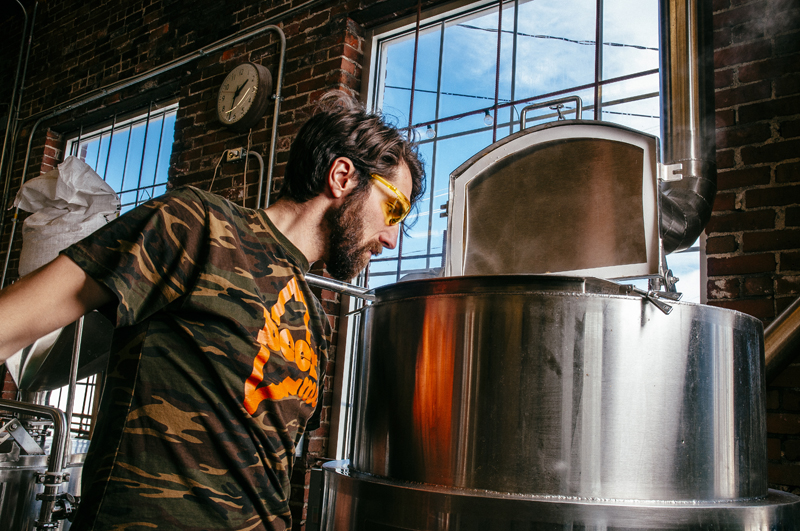Small-Scale Brewers Hold Big Stake in Beer Industry
Like many in the beer industry these days, Dave Peters is looking to expand. His brewing system isn’t keeping up with demand, newer equipment is necessary, and he could stretch out into a little more space. He’s not just ready to double down on his North Carolina-based Bear Creek Brews after four years of producing beer; he’s ready to double its capacity.
From one barrel a week to two.
“I’m getting toward retirement and would like a little time for myself and my wife,” says Peters, who brews and bottles part-time three days a week in space about 75 feet from his home in Bear Creek, North Carolina. “At two barrels a week, I can manage that and we can still have some time off. I know I can sell two barrels a week because right now I’m selling everything before it’s made.”
Peters is like a large number of small-time brewers who are more often staking their claim in the growing industry with tiny operations. They’re honing in on home markets and smaller brewing capacities that offer greater flexibility for time management, pursuing their dream and creating innovative products.
“I’m able to do this as I want, when I want, how I want,” says Peters, who currently brews on a one-barrel system built for an estimated $800 in 2001. He’s spending about $6,000 on another one-barrel system he bought from homebrewing supply store More Beer. “I love that I can experiment without it being a huge investment. I’m self-reliant, self-sufficient and taking control of my own destiny.”
Peters isn’t alone in today’s ever-growing beer industry. While smaller brewery setups—also known as nanobreweries—don’t have an official definition from trade groups like the Brewers Association, they’re generally regarded as brewing less than four barrels per brew session, but may hold the classification for as much as 10 barrels.
In 2013, the National Beer Wholesalers Association reported that 75 percent of American brewers produced 1,000 or less barrels of beer. Using a slightly different formula to track brewery growth, the Brewers Association estimated nearly 67 percent of U.S. breweries at or below 1,000 barrels in 2014, with 46.5 percent producing as little as 500 barrels or less annually.
Even though the numbers may be slightly different, what can be agreed on is that small and often local breweries play a pivotal role in today’s industry.
According to Kinnek, a marketplace that provides equipment quotes for a variety of industries, including brewing, nearly 73 percent of its quote requests between October 2014 and April 2015 were for brewing systems 10 barrels or less. Much of that may have to do with cost—the average brewing system quote on Kinnek for less than four barrels during that time period was $53,000, compared with $109,000 for between four and 10 barrels and $255,500 for 10 barrels and more.
“Small is an important entry point for a lot of people,” says Bart Watson, staff economist for the Brewers Association. “That level of scale allows people to dip their toe in the water without investing a lot of capital into what many may see as a need for a 20- or 30-barrel brewhouse.”
Most important, Watson says, is how the size and scale of nanobreweries play a role in pushing creativity and niche styles or techniques within the industry. Along with small-scale startups, he also pointed to spinoffs from larger businesses that allow brewers to expand offerings, like Bell’s Brewery’s Upper Hand Brewery or The Bruery’s Bruery Terreux.
That ability to play was pivotal for Bunker Brewing, a now-3.5-barrel brewery in Portland, Maine. Surrounded by about 20 breweries within a five-mile radius, Bunker had a plan to stand out that is based around its size. Co-founder and head brewer Chresten Sorensen wanted to be nimble enough to experiment and play, at first procuring a used one-barrel system from Maine Beer Co. in 2011.
“We didn’t have a million dollars and didn’t want to require investors, so we appreciated the freedom that allowed us to start on our own terms in what was essentially a glorified homebrew system,” Sorensen says. “I brewed 40 different kinds of beer that first year, but also wanted to focus on traditional German styles, so being small allowed me to brew however I wanted.”
Sorensen says the initial investment for Bunker Brewing was about $200,000, mostly to build the brewery space in a 1920s-era garage. Piecemeal equipment upgrades over the past four years have cost about $75,000 with plans to break 500 barrels in production this year.
It’s the kind of jump made easier for breweries of his size, which have shown that big changes can start from a small place.
“Everybody is trying to think local these days, and it’s hard to beat what we can do,” says Peters, owner of Bear Creek Brews. “I think there’s a nice market for us out there that makes our beer feel like a ‘homebrew for you.’”



Leave a Reply